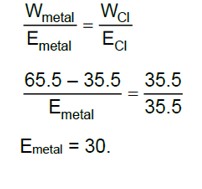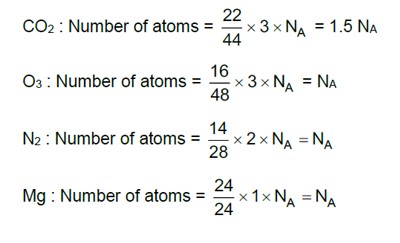1.35. Calcium carbonate reacts with aqueous HCl according to the reaction
CaCO3 (s) + 2HCl (aq) ———->CaCl2 (aq) +CO2(g) +H2O(l).
What mass of CaCO3 is required to react completely with 25 mL of 0.75 M HCl?
1.35. Calcium carbonate reacts with aqueous HCl according to the reaction
CaCO3 (s) + 2HCl (aq) ———->CaCl2 (aq) +CO2(g) +H2O(l).
What mass of CaCO3 is required to react completely with 25 mL of 0.75 M HCl?
-
1 Answer
-
1.35. Step 1: 0.75 M HCl means 0.75 mol per 1000 mL or 0.75 x 36.5 g in 1000 mL.
i.e. 1000 mL of 0.75 M HCl contains 0.75 x 36.5 g HCl
Therefore, 25 mL of 0.75 M HCl contains 0.75 x 36.5 x 25/ 1000 g = 0.6844 g
Step 2: To calculate mass of CaCO3reacting completely with 0.6844 g of HCl
CaCO3 (s) + 2HC1 (aq)———>CaCl2 (aq) +CO2 (g) + H2O
2 mol of HCl, i.e., 2 x 36.5 g = 73 g HCl react completely with CaC03 = 1 mol = 100 gTherefore, 0.6844 g HCl will react completely with CaCO3 = 100/73 x 0.6844 g = 0.938 g
Similar Questions for you
In the medical entrance test NEET, there can be 1 to 3 questions from this chapter. Some year, the Chemistry section of NEET has only one question from this chapter and in some other years, there can be 3 questions.
The following are the key concepts of this chapter: Compound, Elements, Rules, Law of conservation of mass, Addition and Subtraction, Atomic Mass, Law of multiple proportions, and Molecular Mass.
As the name suggests, the first chapter of the NCERT Class 11 Chemistry introduces various basic concepts of chemistry, such as the definition and importance of chemistry, atomic matter and molecular masses, the mole concept, laws of chemical combination, empirical, stoichiometry, and molecular formulas. It also includes the concepts of molarity and molality.
Taking an Exam? Selecting a College?
Get authentic answers from experts, students and alumni that you won't find anywhere else
Sign Up on ShikshaOn Shiksha, get access to
- 65k Colleges
- 1.2k Exams
- 679k Reviews
- 1800k Answers


